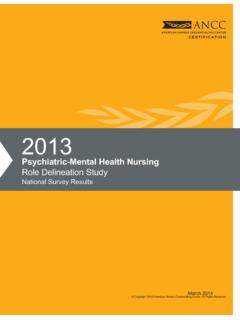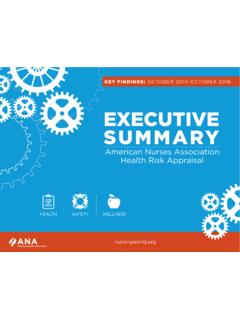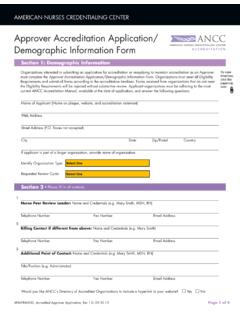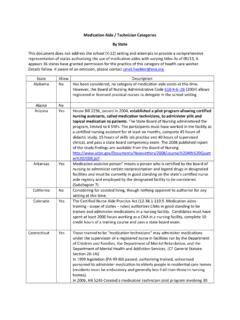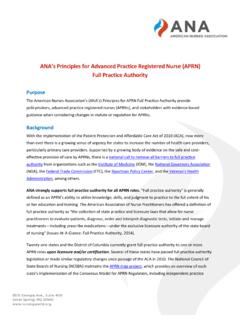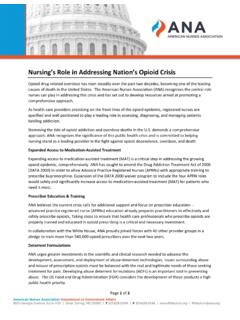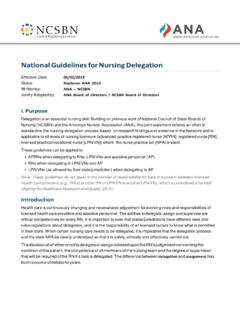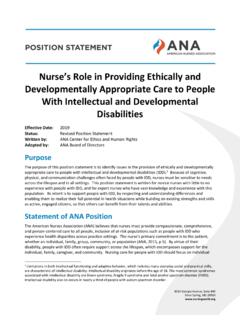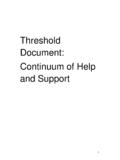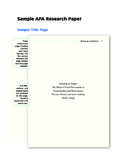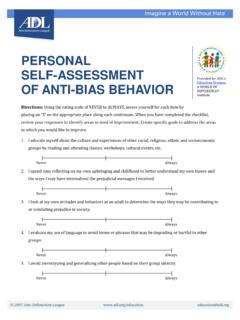Transcription of Nursing Care and DNR Decisions
1 Nursing care and Do Not Resuscitate (DNR) and Allow Natural Death (AND) Decisions Date: March 12, 2012 Status: Revised Position Statement Originated by: ANA Center for Ethics and Human Rights Adopted by: ANA Board of Directors Purpose: Difficulties and confusion about do not resuscitate (DNR) orders still exist, despite efforts to help patients, families, and surrogate decision-makers make informed choices. This statement presents the current literature on barriers that interfere with nurses assisting patients in understanding goals of care and making the decision to have DNR orders written. This statement also makes recommendations for change in the clinical and organizational policy arenas. Statement of ANA Position: Nurses must advocate for and play an active role in initiating discussions about DNR with patients, families, and members of the health care team.
2 Provision of the ANA Code of Ethics for Nurses (2001) states that: Nursing care is directed toward meeting the comprehensive needs of patients and their families across the continuum of care . This is particularly vital in the care of patients and families at the end of life to prevent and relieve the cascade of symptoms and suffering that are commonly associated with dying. Nurses are leaders and vigilant advocates for the delivery of dignified and humane care . Nurses actively participate in assessing and assuring the responsible and appropriate use of interventions in order to minimize unwarranted or unwanted treatment and patient suffering ( ). ANA Position Statement 2 Nursing care and Do Not Resuscitate (DNR) and Allow Natural Death (AND) Decisions History/Previous Position Statements: ANA adopted a position statement on Nursing care and DNR Orders in 2003.
3 This statement was preceded in 1991 by the position statement titled Promotion of Comfort and Relief of Pain in Dying Patients, which indirectly addressed DNR concerns. Supportive Material: Cardiopulmonary resuscitation (CPR) is unique among medical interventions, since it is the only intervention where a presumption to provide the intervention exists, unless there are written physician orders not to do CPR (Bishop, Brothers, Perry, & Ahmad, 2010). Although CPR has been used effectively since the 1960s, the widespread use and possible overuse of this technique and the presumption that it should be used on all patients has been the subject of ongoing debate (Cooper, Cooper, & Cooper, 2006). The efficacy of CPR attempts, balancing of benefits and burdens, and therapeutic goals should be considered in determining if DNR is appropriate.
4 The DNR decision should reflect what the informed patient wants or would have wanted. This demands that communication about end-of-life wishes occur among all involved parties (patient, health care providers, and family; the latter as defined by the patient) and that appropriate DNR orders be written before a life-threatening crisis occurs. If the patient s wishes are unknown, the patient's best interest is the prime consideration. The choices and values of the competent patient should always be given highest priority, even when these wishes conflict with those of the health care team and family. An exception to this is when one or more physicians determine that CPR attempts would be medically ineffective or if the decision of the patient/surrogate is in conflict with the informed opinion of the agency/provider as to what constitutes beneficent care of the patient.
5 In this situation, requests from a patient or surrogate will not be honored (Ditillo, 2002). Agency policies concerning the mechanisms for safe transfer of care by providers/agency must be in place. Additionally, if a DNR decision poses special ethical conflicts for a patient's nurse, mechanisms ANA Position Statement 3 Nursing care and Do Not Resuscitate (DNR) and Allow Natural Death (AND) Decisions need to be in place for transfer of care to another nurse who is competent to care for that patient (ANA, 2001). Expectations that the Patient Self-Determination Act (PSDA) would facilitate communication about DNR orders among physicians and patients have revealed disappointing results. The PSDA has been shown to have much less influence on DNR orders than other physician variables, such as physician specialty (Morrell, Brown, Qi, Drabiak, & Helft, 2008).
6 In addition, terms such as resuscitation, CPR, DNR, full code, and no code do not always mean the same thi ng to everyone (Ells, 2010). Discussion of DNR status should be included whenever goals of treatment, such as the following, are discussed: 1) Benefits versus the burdens of treatment 2) Comfort and symptom palliation 3) Aggressive attempts to sustain life with the understanding that life-sustaining technology will be withdrawn if it does not meet the goals agreed upon by the health care practitioner and patient or family (Kolarik, Arnold, Fischer, & Hanusa, 2002; Prendergast, 2001). Studies show wide variation in whom and what co-morbidities trigger a DNR status. For instance, it has been found that younger patients and cardiovascular patients have a decreased rate of DNR orders written compared to other patients (Holley, Kravet, & Cordts, 2009).
7 Between 1992 and 2005, there was no improvement in survival among hospitalized elders (65 years old or over) on whom CPR was performed (Ehlenbach, et al., 2009). In this same study, in-hospital deaths preceded by CPR increased and the proportion of survivors discharged home after undergoing CPR decreased. Survival rates were lower for men, individuals with more ANA Position Statement 4 Nursing care and Do Not Resuscitate (DNR) and Allow Natural Death (AND) Decisions advanced age, blacks, and those from Nursing homes. Most current rates of survival are recorded at hospital discharge, and range from 1% to 25% for outpatients and 0% to 29% for inpatients (Cooper, Cooper, & Cooper, 2006). Based on the study by Bacchetta, Eachempati, Finns, Hydo, and Barie (2006), patients with a diagnosis of malignant disease (with or without metastasis), cardiovascular disease, or endocrinopathy, and patients receiving chronic glucocorticoid therapy, had higher incidences of DNR orders.
8 Patients who experienced chronic illnesses were more likely to have a DNR order, possibly because they understood the burdens of life -threatening diseases. A history of dementia, cirrhosis, or renal failure did not influence DNR status in this study. Unfortunately, patients who face life-threatening illnesses may have difficulty gaining access to a discussion with their physicians for a variety of reasons, one being the physicians inability to predict accurately and consistently survival or death. A study by White, Engelberg, Wenrich, Lo, and Randall (2007) was designed to discover the content of physicians prognostic reports to family members of ICU patients. Results indicated families with low literacy rates received less information about potential treatment outcomes and thus may have been more likely to misunderstand the patient s true clinical picture.
9 Nurses need to advocate strongly for the patient and family in any situation that renders the patient vulnerable because of physical, emotional, or social circumstances. Good end-of-life care should focus more on what we as nurses provide than what we forgo. According to Dobbins (2007), for patients in long-term care there was no relationship between the presence of formal advance directives and the use of life-sustaining treatments. Also, no relationship was found between the presence of formal or informal advance directives and the ANA Position Statement 5 Nursing care and Do Not Resuscitate (DNR) and Allow Natural Death (AND) Decisions initiation of a comfort care plan. One study found that heart failure patients receive sub-optimal care when a DNR order is in place (Chen, Sosnov, Lessard, & Goldberg, 2008).
10 Patients undergoing surgery pose special considerations. Regarding suspension of DNR status during surgery, strong arguments have been made that seriously or terminally ill patients who consent to surgery do so because they desire functional or palliative effects (Jones & McCullough, 2008). In that case, automatic suspension or automatic continuation of a DNR order cannot be justified (Ball, 2009). The Association of Perioperative Registered Nurses supports both a reconsideration of DNR or allow-natural-death (AND) orders before surgical procedures and that all risks and benefits associated with surgery and anesthesia be discussed with patients who have DNR or AND orders in place before undergoing surgery (AORN, 2010). An order to allow natural death is meant to ensure that only comfort measures are provided.
